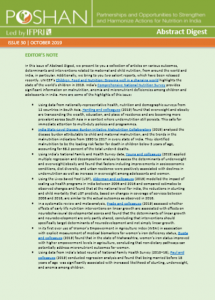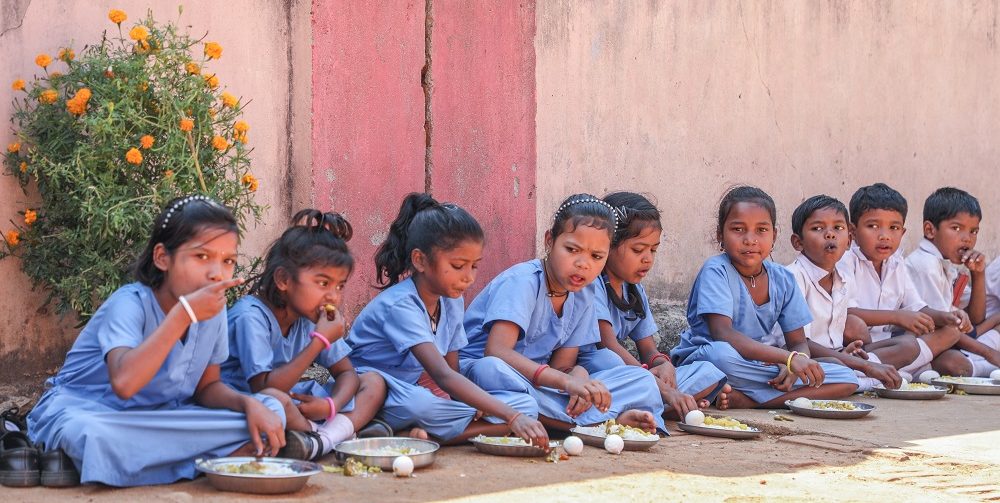
Click HERE to download PDF
In this issue of Abstract Digest, we present to you a collection of articles on various outcomes, determinants and interventions related to maternal and child nutrition, from around the world and India, in particular. Additionally, we bring to you two salient reports, which have been released recently. UNICEF’s Children, Food and Nutrition: Growing well in a changing world highlights the state of the world’s children in 2019. India’s Comprehensive National Nutrition Survey provides significant information on malnutrition, anemia and micronutrient deficiencies among children and adolescents in India. Here are some of the highlights of this issue:
- Using data from nationally-representative health, nutrition and demographic surveys from 12 countries in South Asia, Harding and colleagues (2019) found that overweight and obesity are transcending the wealth, education, and place of residence and are becoming more prevalent across South Asia in a context where undernutrition still persists. This calls for immediate attention to multi-duty policies and programmes.
- India State-Level Disease Burden Initiative Malnutrition Collaborators (2019) analysed the disease burden attributable to child and maternal malnutrition, and the trends in the malnutrition indicators from 1990 to 2017 in every state of India. They identified malnutrition to be the leading risk factor for death in children below 5 years of age, accounting for 68.2 percent of the total under-5 deaths.
- Using India’s National Family and Health Survey data, Young and colleagues (2019) applied multiple regression and decomposition analysis to assess the determinants of underweight and overweight/obesity and found that factors including improvements in socioeconomic conditions, diet diversity, and urban residence were positively associated with declines in undernutrition as well as increase in overweight among adolescents and women.
- Using the Lives Saved Tool (LiST), Alderman and colleagues (2019) modelled the impact of scaling up health programs in India between 2006 and 2016 and compared estimates to observed changes and found that at the national level for India, the reductions in stunting and child mortality that LiST predicts, based on changes in coverage of services between 2006 and 2016, are similar to the actual outcomes as observed in 2016.
- In a systematic review and meta-analysis, Prado and colleagues (2019) assessed whether effects of early life nutrition interventions on linear growth are associated with effects on neurobehavioural developmental scores and found that the determinants of linear growth and neurodevelopment are only partly shared, concluding that interventions should specifically target determinants of neurodevelopment and not simply linear growth.
- In its first ever use of Women’s Empowerment in Agriculture Index (WEAI) in association with explicit measurement of medical biomarkers for women’s iron deficiency status, Gupta and colleagues (2019) found that in the state of Maharashtra, women’s iron status improved with higher empowerment levels in agriculture, concluding that non-dietary pathways can potentially address micronutrient outcomes for women.
- Using data from India’s latest round of National Family Health Survey (2015–16), Paul and colleagues (2019) conducted regression analysis and found that being married before 18 years of age was significantly associated with increased likelihood of stunting, underweight, and anemia among children.
- Using 2015–16 National Family Health Survey data, Dhami and colleagues (2019) investigated the regional prevalence and factors associated with complementary feeding practices in India and found wide differences in regional prevalence and factors associated with complementary feeding practices.
- In a systematic review of complementary feeding interventions in low-and-middle‐income countries (LMICs) Girard and colleagues (2019) noted that behaviour change interventions use a limited set of techniques and depend heavily on education-focused techniques. They called for implementation research to identify, develop, and optimize behaviour change techniques for improving complementary feeding.
- Lo and colleagues (2019) used Demographic and Health Survey data from 77 countries to assess trends and equity across countries and found high variability in coverage within countries as compared to between countries and coverage was high among wealthier populations.
- In a systematic review of 180 studies, describing 39 trials involving 46 intervention arms, Hennessy and colleagues (2019) synthesized evidence for the effectiveness of obesity prevention interventions delivered by health professionals during the first 1000 days period and found that four interventions were effective on a primary (adiposity/weight) and secondary (behavioural) outcome measure.
- Using data from the National Sample Survey Office’s surveys on healthcare, Ghosh and Husain (2019) critically evaluated the impact of India’s National Health Mission on improving utilisation of maternal healthcare services in the state of Bihar, which had very poor maternal and child health outcomes at the start of the mission.
- Murthy and colleagues (2019) conducted a pseudo-randomized controlled trial among pregnant women from urban slums and low-income areas in Mumbai, India, to determine the impact of an mHealth voice message service (mMitra) on infant care knowledge, and practices among low-income women and concluded that tailored mobile voice messages can significantly improve infant care practices and maternal knowledge that can in turn positively impact infant child health.
- Sadruddin and colleagues (2019) conducted a global systematic review focusing on the way grandparents influence child health and development outcomes. They presented a conceptual framework to theorize pathways of care and emphasized the need for data particularly on caregiver contact, behavior, and support.
- Through a matched cohort study, Reese and colleagues (2019) assessed the effectiveness of a community-level combined household piped water and sanitation intervention in rural Odisha, in eastern India, at least 5 years after the completion of intervention, and found that the intervention was associated with a reduction in soil-transmitted helminth infection and improvements in height-for-age.
- In a non-randomised, controlled study with baseline and endline cross-sectional surveys, Gope and colleagues (2019) evaluated the effects of two community strategies to reduce undernutrition among children under three years in rural eastern India, and found reductions in prevalence of stunting, underweight, and wasting among children below three years in areas with crèches, Participatory Learning and Action meetings with women’s groups, and home visits.
- Using cross‐sectional data on women from five states in India, Raghunathan and colleagues (2019) found that participation in self-help group increases women’s access to information and their participation in some agricultural decisions, but has limited impact on agricultural practices or outcomes.
- Based on the experience of adapting and using the Women's Empowerment in Agriculture Index (WEAI) to Indian context, Gupta and colleagues (2019) provided an example of how WEAI can be adapted to a context, generate empirical evidence on the level of women’s empowerment across four locations in the country and test for intra-country variations, and identify aspects of empowerment that are picked up to different degrees by WEAI_India and WEAI.
- A National Consultative Group (2019) constituted by the Nutrition Chapter of the Indian Academy of Pediatrics (IAP), consisting of various stakeholders, reviewed the literature and existing guidelines and policy regulations, and formulated recommendations for limiting consumption of these foods and beverages in Indian children and adolescents.
Enjoy reading!


